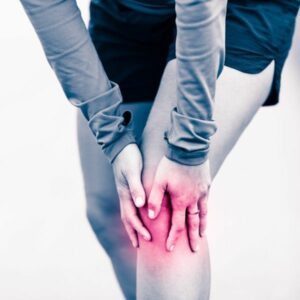Knee OCD (Osteochondritis Dissecans) Specialist

Are you a young athlete who participates in high impact sports with continuous jumping or running? If so, you may be at risk for a rare condition known as osteochondritis dissecans of the knee (OCD). Knee OCD specialist, Doctor James Mazzara, orthopedic knee specialist, provides diagnosis and both surgical and nonsurgical treatment options for patients in Manchester, South Windsor, Enfield, Glastonbury and surrounding Hartford communities who are experiencing symptoms associated with knee OCD. Contact Dr. Mazzara’s team today!
Osteochondritis Dissecans of the Knee (OCD)
What is Osteochondritis Dissecans of the Knee?
Osteochondritis dissecans of the knee, also called OCD of the knee, is a joint condition in which the bone under the cartilage of a joint dies due to a lack of blood supply. The broken bone can break away and cause pain and problems with joint motion. Osteochondritis dissecans occurs most commonly in the knee, but can occur in any joint, including the elbow and ankle.
Children and adolescents are seen most often with osteochondritis dissecans of the knee, especially young athletes that participate in high-impact sports including jumping or running. Patients in Manchester, South Windsor, Enfield, Glastonbury and surrounding Hartford communities can be successfully treated for osteochondritis dissecans of the knee by Dr. James Mazzara, orthopedic knee specialist.
What is JOCD?
Juvenile osteochondritis dissecans of the knee describes the similar pathology of OCD, but in young children. Nine and ten year-olds can develop this condition, but the disease behaves differently than osteochondritis dissecans in adults. While the damage to the knee is similar, the child who is still growing is more likely to heal the bone themselves, without medical intervention. Adults, conversely, are finished growing, therefore the treatments can be very different.
Dr. Mazzara and many other orthopedic specialists believe that JOCD is caused by repeated stress to the bone. Young athletes who have been involved with competitive sports at a very early age are more likely to have symptoms of JOCD. Also, heavy training and competition schedules for children can stress the femur (leg bone) in a way that leads to juvenile osteochondritis dissecans of the knee.
Most young people with JOCD have been involved in competitive sports since they were very young. A heavy schedule of training and competing can stress the femur in a way that leads to JOCD. In some cases, other muscle.
What Causes OCD in an Adult?
The cause of osteochondritis dissecans in all joints is unknown. Repetitive trauma may cause a reduced blood flow to the end of the bone, resulting in necrosis; or multiple, small episodes of trauma that does not heal may contribute to an injury that damages the bone. Some physicians believe there is a genetic component, making some people more susceptible to the disorder.
What are the Symptoms of OCD or JOCD of the Knee?
Knee joint pain and swelling, often brought on by a sports activity are the first indicators of osteochondritis dissecans. Other symptoms may include stiffness, knee instability, tenderness when moving the knee or a locking and clicking sensation.
How is Osteochondritis Dissecans of the Knee Diagnosed?
Dr. Mazzara will conduct a thorough medical history as well as physical examination of the patient’s knee. Range of motion and tenderness of the joint, as well as any clicking or popping will be noted. X-rays are needed to confirm the diagnosis and on occasion, a bone scan is requested.
A bone scan is similar to an x-ray in that it takes pictures of the bones with a special camera. During a bone scan, the technician can inject a special type of dye into the blood stream. The special camera can see the dye, which attaches itself to areas of bone that are undergoing rapid changes, such as healing a fracture. A bone scan is the best way to see the lesions in the very early stages of OCD.
An MRI is necessary to evaluate the severity of the OCD lesion. The MRI will determine if the lesion can heal without surgery and whether the overlying cartilage is still intact or damaged.
How is Osteochondritis Dissecans of the Knee Treated?
Treatment of OCD and JOCD is intended to restore the normal function of the affected joint while alleviating pain. It is important to reduce the risk of osteoarthritis by discontinuing the activity that caused OCD or JOCD.
In most cases, JOCD lesions in children and young teens will heal on their own, especially when the bones are still growing. Treatment for older teens and adults begins with complete rest from the activity. Anti-inflammatory medications may be recommended to ease the pain by reducing swelling and inflammation in the knee.
What is the Surgical Treatment for Osteochondritis Dissecans of the Knee?
There are different surgical techniques to treat osteochondritis dissecans of the knee. Dr. Mazzara will base the treatment on the age, activity level, health and on the size and grade of the lesion the patient has. Some of the possible treatments may include:
- To encourage healing of surrounding bone, a hole, drilled into the lesion can be done to create pathways for new blood vessels to nourish the affected area.
- The lesion may be held in place with pins and screws – called internal fixation.
- To help regenerate healthy bone in the area damaged, a graft may be used to replace the damaged area with a new piece of bone and cartilage.
How Long Does it Take to Recover from OCD Treatment?
Recovery times vary, based on the extent of injury in osteochondritis dissecans of the knee. Treatment often lasts eight weeks to four months and is followed by a physical therapy program to strengthen the areas around the injured joint. It is important to follow through with follow-up visits with Dr. Mazzara to continue to heal and to make certain the lesion is not being further damaged.
For more information on osteochondritis dissecans of the knee, please contact the orthopedic office of Dr. James Mazzara, knee specialist, serving patients living in Manchester, South Windsor, Enfield, Glastonbury and surrounding Hartford Connecticut communities.
